Course Tour
Front 9
Hole 1
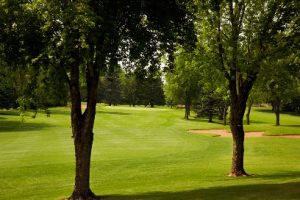 The first hole gives warning that this may not be an easy day. It’s a 434-yard par 4 from the blues and a 375-yard par 5 for women hitting from the reds. From an elevated tee, the fairway slopes down to the corner of a dogleg left. There’s water on the left and trees on both sides. A drive to the corner leaves an uphill shot of 190 to 210 yards. Long hitters can cut the corner to get to within 160 yards. The green is guarded on the left by a large, overhanging tree 40 yards short of the green, as well as a greenside bunker. Bailing out to the right leaves a tricky pitch to a contoured green that slopes from back to front. Should you go long, you’re faced with a row of mature spruces and a chip to a green that runs away from you.
The first hole gives warning that this may not be an easy day. It’s a 434-yard par 4 from the blues and a 375-yard par 5 for women hitting from the reds. From an elevated tee, the fairway slopes down to the corner of a dogleg left. There’s water on the left and trees on both sides. A drive to the corner leaves an uphill shot of 190 to 210 yards. Long hitters can cut the corner to get to within 160 yards. The green is guarded on the left by a large, overhanging tree 40 yards short of the green, as well as a greenside bunker. Bailing out to the right leaves a tricky pitch to a contoured green that slopes from back to front. Should you go long, you’re faced with a row of mature spruces and a chip to a green that runs away from you.
Hole 2
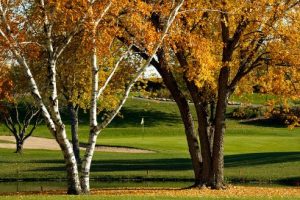 Number 2 is a dogleg left, playing at 383 yards from the blues down to 349 from the reds. From the tee, the left side is guarded by trees and a fairway bunker in the landing area, about 150 yards from the green. The right side features mature trees ready to catch the unwary. From the 150 markers, the fairway slopes down gently to the green. There’s water on the left at about 80 yards from the green. The elevated green is small, with a false front and a steep bank behind. Greenside bunkers left and right complete a challenging little hole.
Number 2 is a dogleg left, playing at 383 yards from the blues down to 349 from the reds. From the tee, the left side is guarded by trees and a fairway bunker in the landing area, about 150 yards from the green. The right side features mature trees ready to catch the unwary. From the 150 markers, the fairway slopes down gently to the green. There’s water on the left at about 80 yards from the green. The elevated green is small, with a false front and a steep bank behind. Greenside bunkers left and right complete a challenging little hole.
Hole 3
 The third hole is our longest par 3, playing at 210 yards from the blues, down to 170 from the reds, providing a good test of long iron or fairway wood. Both green and tee are elevated, with a steep bank in front of the green. The entrance road on the left is out of bounds and there are two greenside bunkers. The right side is guarded by a number of mature trees, as well as a bank sloping up from the green. The green itself is of medium size. A number of subtle breaks belie the apparent flatness.
The third hole is our longest par 3, playing at 210 yards from the blues, down to 170 from the reds, providing a good test of long iron or fairway wood. Both green and tee are elevated, with a steep bank in front of the green. The entrance road on the left is out of bounds and there are two greenside bunkers. The right side is guarded by a number of mature trees, as well as a bank sloping up from the green. The green itself is of medium size. A number of subtle breaks belie the apparent flatness.
Hole 4
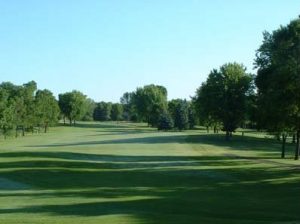 Number 4 is a deceptive hole, relatively easy for the straight hitter with some local knowledge, but with a few snares for the unwary. A narrow strip of rough separates the fairway from the out of bounds down the left side. On the right, the rough slopes down toward the second fairway. Hit it here and you’re faced with a difficult shot over, under, or around mature tees, including a tall one guarding the green. From the fairway, you have a semi-blind approach to a large, flat green flanked by bunkers right and left. Since you can’t see the putting surface, the tendency is to come up short. The putting surface is relatively flat, but with gentle, subtle breaks to surprise you.
Number 4 is a deceptive hole, relatively easy for the straight hitter with some local knowledge, but with a few snares for the unwary. A narrow strip of rough separates the fairway from the out of bounds down the left side. On the right, the rough slopes down toward the second fairway. Hit it here and you’re faced with a difficult shot over, under, or around mature tees, including a tall one guarding the green. From the fairway, you have a semi-blind approach to a large, flat green flanked by bunkers right and left. Since you can’t see the putting surface, the tendency is to come up short. The putting surface is relatively flat, but with gentle, subtle breaks to surprise you.
Hole 5
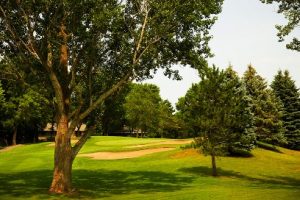 The fifth hole is a relatively short par 5, playing 487 yards from the blues and 440 from the reds. It’s not too difficult, if you can keep the ball in the fairway. But stray from the short grass and seven or even eight can enter the picture. The left side is guarded by mature trees, beyond which is out of bounds. The right side also has its share of trees, giving you the opportunity to be inventive. There’s a pond left of the fairway, extending from 100 yards to 30 yards from the green. The green itself is elevated, with a slight false front that can cause trouble if your approach comes up a little short. Bunkers flank the green, one on the left and two on the right. An approach that’s too hot might wind up down the bank behind the green, leaving a tricky pitch to a green that’s sloping away.
The fifth hole is a relatively short par 5, playing 487 yards from the blues and 440 from the reds. It’s not too difficult, if you can keep the ball in the fairway. But stray from the short grass and seven or even eight can enter the picture. The left side is guarded by mature trees, beyond which is out of bounds. The right side also has its share of trees, giving you the opportunity to be inventive. There’s a pond left of the fairway, extending from 100 yards to 30 yards from the green. The green itself is elevated, with a slight false front that can cause trouble if your approach comes up a little short. Bunkers flank the green, one on the left and two on the right. An approach that’s too hot might wind up down the bank behind the green, leaving a tricky pitch to a green that’s sloping away.
Hole 6
 The sixth hole is a scenic par 3, playing at 182 yards from the blues, to 140 from the reds. Generally, a mid-iron to a 7-wood will suffice, but beware the water on the left. In addition, trees left and right and a bunker front right make for an interesting tee shot. Many a ball has caromed off the trees on the left and found a watery grave. The tee shot is most of the battle on this hole. The green is relatively flat, but with some interesting undulations.
The sixth hole is a scenic par 3, playing at 182 yards from the blues, to 140 from the reds. Generally, a mid-iron to a 7-wood will suffice, but beware the water on the left. In addition, trees left and right and a bunker front right make for an interesting tee shot. Many a ball has caromed off the trees on the left and found a watery grave. The tee shot is most of the battle on this hole. The green is relatively flat, but with some interesting undulations.
Hole 7
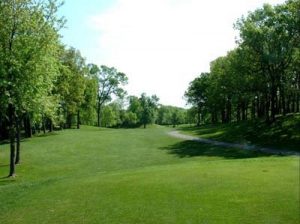 The seventh hole is the number one handicap hole at Forest Hills. It’s a long par 4, playing at 452 yards from the blues. Gold and red tee players enjoy a substantial advantage, playing at about 350 yards. From the blue and white tees the hole is a dogleg right, with mature trees lining the fairway from the tee to the corner, about 125 yards out. The big hitter can cut the corner, but cutting too much risks tree trouble around the corner. The fairway is tree-lined on both sides. On the approach shot, the player is well-advised to stay below the hole, particularly if the pin is in the back of the green. Most often, putts from above the hole result in either one or three putts, seldom two. Seven is a thorough test of golfing skill.
The seventh hole is the number one handicap hole at Forest Hills. It’s a long par 4, playing at 452 yards from the blues. Gold and red tee players enjoy a substantial advantage, playing at about 350 yards. From the blue and white tees the hole is a dogleg right, with mature trees lining the fairway from the tee to the corner, about 125 yards out. The big hitter can cut the corner, but cutting too much risks tree trouble around the corner. The fairway is tree-lined on both sides. On the approach shot, the player is well-advised to stay below the hole, particularly if the pin is in the back of the green. Most often, putts from above the hole result in either one or three putts, seldom two. Seven is a thorough test of golfing skill.
Hole 8
 Number 8 is a relatively long par 5, playing at 542 yards from the blues. The red tees play at 411 yards. From the tee, the fairway undulates gently to a dogleg right about 340 yards away. Both sides are guarded by trees. In addition, out of bounds lurks on the right, while tree-covered hills on both sides add to the difficulties. Around the dogleg, the golfer is faced with more trees on the right and a pond on the left extending from about 125 yards all the way to the green. The green itself is guarded by two bunkers on the right. A too-long approach generally leaves the player with a tricky chip to a green that slopes away. Finally, there are a number of treacherous pin placements to challenge putting skill.
Number 8 is a relatively long par 5, playing at 542 yards from the blues. The red tees play at 411 yards. From the tee, the fairway undulates gently to a dogleg right about 340 yards away. Both sides are guarded by trees. In addition, out of bounds lurks on the right, while tree-covered hills on both sides add to the difficulties. Around the dogleg, the golfer is faced with more trees on the right and a pond on the left extending from about 125 yards all the way to the green. The green itself is guarded by two bunkers on the right. A too-long approach generally leaves the player with a tricky chip to a green that slopes away. Finally, there are a number of treacherous pin placements to challenge putting skill.
Hole 9
 Number 9 is a short, tame-looking par 4, playing 320 from the blues and 257 from the reds. From the elevated tee, the hole drops to a flat area extending to about 125 yards from the green. A pond short and right may come into play for the shorter hitter. From the flat, the fairway ascends to a plateau that is reachable from the tee for a long hitter, then higher still to the green. The fairway is guarded on the left by two large bunkers, a number of mature trees, and a steep drop-off. On the right there are more trees, including some of Forest Hills’ infamous arbor vitae. Stray from the fairway and par becomes a very good score. The fairway rises sharply to the two-tiered green guarded by bunkers left and right. A short approach shot is apt to roll back a considerable distance. But if you go long and the pin is in front, you are faced with a downhill chip or long putt that also may end up going down the hill. A simple hole, but with hidden teeth.
Number 9 is a short, tame-looking par 4, playing 320 from the blues and 257 from the reds. From the elevated tee, the hole drops to a flat area extending to about 125 yards from the green. A pond short and right may come into play for the shorter hitter. From the flat, the fairway ascends to a plateau that is reachable from the tee for a long hitter, then higher still to the green. The fairway is guarded on the left by two large bunkers, a number of mature trees, and a steep drop-off. On the right there are more trees, including some of Forest Hills’ infamous arbor vitae. Stray from the fairway and par becomes a very good score. The fairway rises sharply to the two-tiered green guarded by bunkers left and right. A short approach shot is apt to roll back a considerable distance. But if you go long and the pin is in front, you are faced with a downhill chip or long putt that also may end up going down the hill. A simple hole, but with hidden teeth.
Back 9
Hole 10
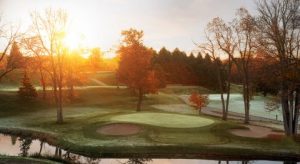 The tenth is a Forest Hills signature hole. It’s a lovely little par 3, measuring only 134 from the back tee and 101 from the forward tee. The tees are elevated, with a fine view of the pond that extends the full width of the hole. An accurate, well-struck shot finds a receptive green and a good birdie opportunity. A shot short of the green gives a good chance at par. Even a shot that finds one of the bunkers flanking the green may allow a par save. But beware the shot that misses long or wide. Then you’ll be faced with a delicate pitch under, between or through overhanging trees to the elevated green. Another “easy” hole.
The tenth is a Forest Hills signature hole. It’s a lovely little par 3, measuring only 134 from the back tee and 101 from the forward tee. The tees are elevated, with a fine view of the pond that extends the full width of the hole. An accurate, well-struck shot finds a receptive green and a good birdie opportunity. A shot short of the green gives a good chance at par. Even a shot that finds one of the bunkers flanking the green may allow a par save. But beware the shot that misses long or wide. Then you’ll be faced with a delicate pitch under, between or through overhanging trees to the elevated green. Another “easy” hole.
Hole 11
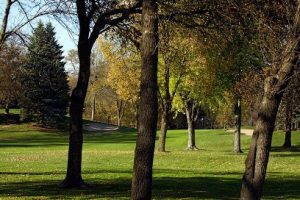 The eleventh hole is a straightforward par 4, playing from 361 to 341 yards. The slightly elevated tee looks out at a relatively flat fairway. A small pond to the left of the tee should not (but sometimes does) come into play. Trees line the fairway both left and right. While not numerous, they provide opportunities for good recovery shots. The green is guarded by bunkers both left and right. The false front often proves frustrating for the golfer whose approach shot comes up short. But a shot that goes long may encounter a bank that runs down toward a marshy hazard, leaving a tricky pitch to a green running away.
The eleventh hole is a straightforward par 4, playing from 361 to 341 yards. The slightly elevated tee looks out at a relatively flat fairway. A small pond to the left of the tee should not (but sometimes does) come into play. Trees line the fairway both left and right. While not numerous, they provide opportunities for good recovery shots. The green is guarded by bunkers both left and right. The false front often proves frustrating for the golfer whose approach shot comes up short. But a shot that goes long may encounter a bank that runs down toward a marshy hazard, leaving a tricky pitch to a green running away.
Hole 12
 Number 12 is a straight par 4, measuring 349 from the back tees and 290 from the reds. Its dominating feature is an uphill slope extending from 200 to 150 yards from the green. A tee shot that makes it to the top of the hill leaves a simple short- to mid-iron shot to one of our larger greens. Off the tee, there are large trees both left and right to catch the errant shot. On the left side, at the top of the hill, there’s a large fairway bunker. The green is guarded by bunkers left and right. If you miss left of the green, you may find yourself at the bottom of a steep, 30-foot slope with an interesting shot over or through trees. Miss to the right and the ball is likely to run into a stand of spruces or even down to the thirteenth tee. Miss long and there are more spruces to contend with. A simple hole for the straight hitter.
Number 12 is a straight par 4, measuring 349 from the back tees and 290 from the reds. Its dominating feature is an uphill slope extending from 200 to 150 yards from the green. A tee shot that makes it to the top of the hill leaves a simple short- to mid-iron shot to one of our larger greens. Off the tee, there are large trees both left and right to catch the errant shot. On the left side, at the top of the hill, there’s a large fairway bunker. The green is guarded by bunkers left and right. If you miss left of the green, you may find yourself at the bottom of a steep, 30-foot slope with an interesting shot over or through trees. Miss to the right and the ball is likely to run into a stand of spruces or even down to the thirteenth tee. Miss long and there are more spruces to contend with. A simple hole for the straight hitter.
Hole 13
 Number 13 is a relatively short par 3. A well-struck tee shot should find the large green easily. The pond extending halfway across the hole in front should be no problem. The green is guarded on the left by a bunker. Trees are scattered on both sides, but generally cause little trouble. Most of the adventures on thirteen are on or around the green. It slopes severely from back to front, making it important to be below the hole. A chip or putt from the back toward a front pin can be hazardous to your score.
Number 13 is a relatively short par 3. A well-struck tee shot should find the large green easily. The pond extending halfway across the hole in front should be no problem. The green is guarded on the left by a bunker. Trees are scattered on both sides, but generally cause little trouble. Most of the adventures on thirteen are on or around the green. It slopes severely from back to front, making it important to be below the hole. A chip or putt from the back toward a front pin can be hazardous to your score.
Hole 14
 Fourteen isthe number two handicap hole, and deservedly so. It’s the longest hole on the course, playing at 553, 549, 492, and 483 yards. From the elevated blue or white tee, you’re faced with a seemingly generous width of fairway. However, the presence of the out of bounds stakes all the way along the right, along with thick trees on the left side, make the tee shot just a bit more difficult. A well-placed tee ball near the corner of the dogleg left rewards the player with a straightforward fairway wood or long iron to get the ball into mid- to short-iron range. The green is guarded by a marshy pond short and left and a wooded hill next to, and only five yards from, the green. On the right, a small bay of Shields Lake runs all along the green. The green itself is relatively easy, unless the pin is back right and you’re putting from the front left.
Fourteen isthe number two handicap hole, and deservedly so. It’s the longest hole on the course, playing at 553, 549, 492, and 483 yards. From the elevated blue or white tee, you’re faced with a seemingly generous width of fairway. However, the presence of the out of bounds stakes all the way along the right, along with thick trees on the left side, make the tee shot just a bit more difficult. A well-placed tee ball near the corner of the dogleg left rewards the player with a straightforward fairway wood or long iron to get the ball into mid- to short-iron range. The green is guarded by a marshy pond short and left and a wooded hill next to, and only five yards from, the green. On the right, a small bay of Shields Lake runs all along the green. The green itself is relatively easy, unless the pin is back right and you’re putting from the front left.
Hole 15
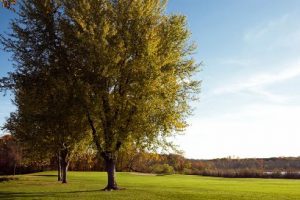 Number 15 is the other signature hole at Forest Hills. Not overly long, it plays to a par of 4 from 392 yards (blue) to 325 (red). But the fairway curls around Shields Lake giving easy access to trouble on all shots, until the green is reached. A drive that runs through the fairway may find some tree trouble, but the left side of the hole is reasonably safe. The big hitter can bite off quite a bit of the lake curvature, leaving a short iron to the green and little danger from the lake. The rest of us generally face a more intimidating mid-iron or fairway wood over a corner of the lake. If the pin is middle to back, the approach also must carry over a greenside bunker on the right. Even the layup has its dangers. Directly ahead, before the last turn to the green, is a pond ready to catch a too-long layup. The green itself slopes from back to front and is relatively easy to negotiate, though its size can leave you with a long putt.
Number 15 is the other signature hole at Forest Hills. Not overly long, it plays to a par of 4 from 392 yards (blue) to 325 (red). But the fairway curls around Shields Lake giving easy access to trouble on all shots, until the green is reached. A drive that runs through the fairway may find some tree trouble, but the left side of the hole is reasonably safe. The big hitter can bite off quite a bit of the lake curvature, leaving a short iron to the green and little danger from the lake. The rest of us generally face a more intimidating mid-iron or fairway wood over a corner of the lake. If the pin is middle to back, the approach also must carry over a greenside bunker on the right. Even the layup has its dangers. Directly ahead, before the last turn to the green, is a pond ready to catch a too-long layup. The green itself slopes from back to front and is relatively easy to negotiate, though its size can leave you with a long putt.
Hole 16
 Sixteen is a normal-length par five that measures 504 yards from the blues and 410 from the reds. However, the severely elevated green adds 10 to 20 yards to its length — even more if the approach is made with a long iron or fairway wood. It’s a dogleg left, but the garden spot off the tee is the right half of the fairway, avoiding a second shot over the trees at the corner. The fairway is lined with trees both left and right, though the ones on the left make it unlikely that the green can be reached in regulation from their midst. The approach shot is critical on number 16, due to the elevation of the green, which makes it hard to hold. Many a shot finds its way to the rough back of the green. Go too far, and you’ll be in “lost-ball” territory in heavy brush. Chipping from behind the green to a front pin, with the downslope looming, is no bargain. A challenging hole.
Sixteen is a normal-length par five that measures 504 yards from the blues and 410 from the reds. However, the severely elevated green adds 10 to 20 yards to its length — even more if the approach is made with a long iron or fairway wood. It’s a dogleg left, but the garden spot off the tee is the right half of the fairway, avoiding a second shot over the trees at the corner. The fairway is lined with trees both left and right, though the ones on the left make it unlikely that the green can be reached in regulation from their midst. The approach shot is critical on number 16, due to the elevation of the green, which makes it hard to hold. Many a shot finds its way to the rough back of the green. Go too far, and you’ll be in “lost-ball” territory in heavy brush. Chipping from behind the green to a front pin, with the downslope looming, is no bargain. A challenging hole.
Hole 17
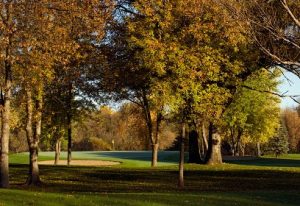 Number 17 is a short, easy par 4 — if you hit it straight. It’s only 310 from the blues and 220 from the reds to a dogleg left, with mature trees guarding the corner. If your tee ball lands there, you’re presented with a tricky shot under the trees and over a greenside bunker to a green that has a severe drop-off behind it, from which recovery is problematic, at best. The wise choice is to take your medicine and chip out in front of the green, looking for an up-and-down. Don’t chip too far, however, lest you wind up in the right greenside bunker. Once you reach the green, the fun can begin. The green slopes severely from back to front, giving ample opportunity for three or four putts for those whose first one is from above the hole.
Number 17 is a short, easy par 4 — if you hit it straight. It’s only 310 from the blues and 220 from the reds to a dogleg left, with mature trees guarding the corner. If your tee ball lands there, you’re presented with a tricky shot under the trees and over a greenside bunker to a green that has a severe drop-off behind it, from which recovery is problematic, at best. The wise choice is to take your medicine and chip out in front of the green, looking for an up-and-down. Don’t chip too far, however, lest you wind up in the right greenside bunker. Once you reach the green, the fun can begin. The green slopes severely from back to front, giving ample opportunity for three or four putts for those whose first one is from above the hole.
Hole 18
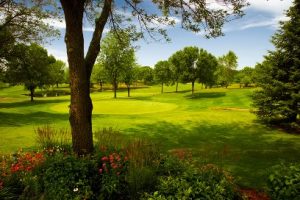 Number 18 is a moderate finishing hole. It plays to a par four from 386 yards (blue) to 268 yards (red). One difficulty is the steep upslope in the landing area for the short to medium male hitter and directly in front of the red tee for the ladies. The ideal tee shot is down the left side to cut the dogleg, but beware the arbor vitae and fairway bunker on that side. In addition, if your tee shot lands in the left rough, your approach must clear several mature trees about 90 yards from the green. A well-struck, accurate tee ball leaves the player with a short- to mid-iron shot to a small, elevated green. The approach shot must carry to the green, due to a steep bank in front, but the size of the green makes it hard to hold anything longer than an eight iron. The green is relatively flat, but with some subtle, interesting breaks. A good general rule is that it breaks more than you think.
Number 18 is a moderate finishing hole. It plays to a par four from 386 yards (blue) to 268 yards (red). One difficulty is the steep upslope in the landing area for the short to medium male hitter and directly in front of the red tee for the ladies. The ideal tee shot is down the left side to cut the dogleg, but beware the arbor vitae and fairway bunker on that side. In addition, if your tee shot lands in the left rough, your approach must clear several mature trees about 90 yards from the green. A well-struck, accurate tee ball leaves the player with a short- to mid-iron shot to a small, elevated green. The approach shot must carry to the green, due to a steep bank in front, but the size of the green makes it hard to hold anything longer than an eight iron. The green is relatively flat, but with some subtle, interesting breaks. A good general rule is that it breaks more than you think.
